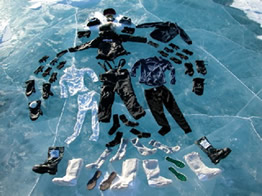
Picture - Pen Hadlow Clothing
Clothing
The key
to a clothing system that works is layering. And what you are
really developing, for any climate and activity, is a system of clothing that
can be changed as needed to suit conditions.
Some people can get away with very minimal gear whilst exercising hard but everyone
will need to wrap up again when stationary.

Picture -
Pen Hadlow Clothing
Let's look at the layers, one at a time. There are three layers in any system where you are trying to stay warm:
Wicking layer -- This transports moisture (perspiration) away from the skin as efficiently as possible. New fabrics based on synthetics are amazing in this regard. Cotton and wool is your worst enemy in the field because they do a poor job of transporting heat and perspiration, and once wet, tend to stay wet for an incredibly long time. In extreme cold, once wet, you lose a massive amount of your body heat immediately. With today's advanced fibres, there is no reason to risk hypothermia by using natural fibres such as cotton or wool in the wicking layer.
Insulating layer -- This is where you are trapping body heat, while allowing perspiration to escape. All types of polar fleece fabrics work well here. I have noticed that there is polar fleece, and there is polar fleece -- in other words, you get what you pay for. Cheap discount brand fleece quickly will compress and pill, and lose insulating value. This is not a place to save money, or you will be unhappy in the field! Stay with fleece produced by name brand outdoor manufacturers, or cloth made at Malden Mills (the pioneer of synthetic fleece). Some people still prefer to wear a wool insulating layer. Wool is very efficient and durable as an insulator, but if you are in the field for any length of time and it gets wet, it will take forever to dry out -- and you will be cold until it does. In extreme cold and when generating lots of body heat, it's unlikely wool will transport the excess moisture out of your clothing system fast enough. Synthetics are now less expensive, do not retain moisture, and dry quickly if they do become wet.
Shell layer -- The outer layer is a shell to stop wind and moisture. Note that I didn't say "waterproof" or "water resistant". Waterproof fabrics (such as rain gear), do not allow moisture to escape; which only results in you getting wet, with all the problems that entails. Water resistant fabrics such as Gore-Tex tend to not breathe well in extreme cold. Basic shells for extreme cold weather should be cotton in a very tight weave, cotton/polyester blend, or a synthetic fabric such as pure polyester or breathable nylon.
In addition to the clothing system, I try to carry tools which can fix any problem I have in the field, as well as navigation aids. Equipment that is always with me include: Gerber multi-purpose tool, whistle, flashlight like the Black Diamond LED torch, Silva compass, plastic bivi bag (for shelter) and a Garmin GPS. A small snack (chocolate?) Hat and gloves in my pockets with some string and for the car - Duct tape - for a quick fix!
Obviously
your choice of foot wear - Boots will depend on the terrain and you should leave
an expected endex time / route taken where it can be found should you need finding
- but then of course you would have consulted your up to date map anyway and
studied the contours when you planned your route - remember stick to your plan.